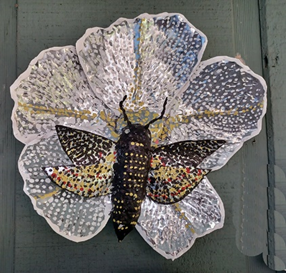The Naughty Little Secret of Pollination
Pollination is a complex mutual process that has evolved to
insure the survival of animal and plant species. The pollinator species seeking
food transfers gametes of the plant species producing offspring. The pollinator
receives nutrition while the plant increases genetic diversity in the
population
The prototype for this series was a Trillium and a generic
bee.
 |
This hanging sculpture, created in galvanized steel and
decorated with exterior house paint, now lives with Becky in Chapel Hill, NC.
 |
These sculptures are made from galvanized roof flashing cut
out with Joyce Chen chicken boning scissors. They are shaped by chasing and repose
techniques. Details are painted in exterior house paint using pointillism to
produce a light and motion effect. The series will be on exhibit at the NC
Botanical Garden starting in September.
Blue Salvia and Ruby Throated Hummingbird
Hummingbirds drink up to two times their body weight per day. As they move from plant to plant, they carry pollen. They pollinate the native wildflowers and decorative cultivars. Hummingbirds are only found in the western hemisphere.
Moonflower and Hawkmoth
The hawk moth drinks nectar from sweet-smelling flowers, many of which bloom at night. Most hawk moth species have a long proboscis. This hollow, tongue-like appendage is used to access nectar deep inside flowers. Pollen sticks to the moth’s face, proboscis, and legs when it feeds. It then transports the pollen to successive flowers.
Bee Balm and Hummingbird Moth
Hummingbird
moths share many common characteristics with hummingbirds. Both of these
creatures are effective pollinators of many of the same flowers, and
hummingbird moths also sip nectar from many of the same blooms that hummingbirds
prefer.
Dogwood and Honeybee
Honeybees,
which came from Europe to North America with colonists, are social insects and
live together in nests or hives. Honeybees are remarkable for the “dancing” movements
they perform in the hive to communicate information to their fellow bees about
the location of a particular food source in the surrounding area. Honeybees are
America’s primary commercial pollinator. Plants include almonds, non-citrus
fruit and decorative trees, berries, melons, and squash.
Daisy
and Bumble Bee
Big
fuzzy bumblebees pollinate flowers through a method called “buzz pollination,” a rapid vibrating motion which releases large amounts of pollen onto the bee.
In most situations, “buzz pollination” will allow a bumblebee to pollinate a
flower in a single visit. They are important pollinators of wild flowering
plants and crops. As generalist foragers, they do not depend on any one flower
type. However, some plants do rely on bumble bees to achieve pollination.
Vinca and Blue Orchard Bee
The
blue orchard bee is a native solitary mason bee in the United States and
Canada. It is of great interest for use as a native pollinator of fruit trees
and blueberries. Blue Orchard Bees emerge early in the spring and therefore pollinate early flowering species.
Squash and Mason Bee
Another
solitary native bee, Mason bees are efficient pollinators of native plants such
as pumpkins, beans and squash.
Sunflower and Monarch Butterfly
Monarchs are not the most efficient pollinators, they can and do pollinate some plants. Monarchs are considered a flagship species or a poster species for all pollinators. Goldenrod, Butterfly Bush, Cosmos, Lantana, Lilac, and Zinnia are some plants that attract Monarchs.
Hibiscus and Tiger Swallowtail Butterfly
Among the nectar
plants of the tiger swallowtail are butterfly bush, cone flower, milkweed,
phlox, lilac, ironweed, and wild cherry.
Poppy and Sulphur Butterfly
 |
| Vincent |
This
pollinator pairing is inspired by one of my favorite Van Gogh paintings. I saw
it on one of my visits to his museum in Amsterdam.
English Daisy and Azure Blue Butterfly
The Azure Blue is found in North America and Great Britain. It is found in a variety of grassy habitats. The brightly colored males are conspicuous, but females are more secretive.
Magnolia and Lady Bug Beetle
Magnolias among the oldest of the flowering plants, evolving earlier than many common pollinators such as bees, butterflies. They accordingly developed flowers for pollination by beetles and flies, which were the primary insect pollinators 100 million years ago.
The accompanying notes are paraphrased from a variety of online
sources without reference. I intend them only to give perspective to my
thinking in creating the works.
Forrest














No comments:
Post a Comment